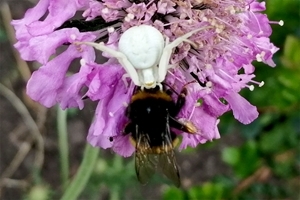Crab spider
 Lots of us are arachnophobes, and we have evolved to be for good reason because, in many parts of the world, spider bites have caused human illness and death. They say spiders in the UK are not a threat. However, I myself am nursing a split lip as I write, because I walked headfirst into an orb spider web in the garden and hit myself in the face with a trowel when I panicked.
Lots of us are arachnophobes, and we have evolved to be for good reason because, in many parts of the world, spider bites have caused human illness and death. They say spiders in the UK are not a threat. However, I myself am nursing a split lip as I write, because I walked headfirst into an orb spider web in the garden and hit myself in the face with a trowel when I panicked.
Truly, though, our native UK spiders are relatively benign. I encountered the particular species that I am going to write about when I was dead-heading my scabious plant in the garden and noticed a pile of dead bumblebees beneath the plant. I thought it was odd that they would all die naturally in the same spot, so I looked on the flowerheads and soon spotted the culprit (cue sharp intake of breath).
The crab spider (Misumena vatia) is so-named because its long front legs are arranged in a crab-like fashion, and it can run sideways. Seen between May and August, it is the most common flower spider and the females are larger and more often seen than the males. Females are most often encountered feeding on bumblebees, honeybees, butterflies, moths, hoverflies, and whatever other juicy flower visitors arrive, whereas males have a busier life climbing up and down flowers looking for mates, and eating the occasional insect and piece of pollen to fuel their quest.
Unlike many spiders, they don’t spin webs to trap insects. Their feeding strategy is a cunning combination of ambush and camouflage. Crab spiders are capable of changing colour to match their chosen flower, so long as it is on a spectrum between pale green, yellow, white and pale pink. On a pale flower like yarrow, the spider is well disguised in its natural form, and sometimes they have reddish marks on their abdomen and thorax to break up their outline. If a spider chooses a yellow flower, they embark on a pigment-production process which can take up to three weeks, slowly turning the outer layer of cells on their body to yellow. To reverse to white, they can metabolise this pigment back into the deeper layers of the body. A lab study found that the spiders take visual cues to change colour, because spiders whose eyes were painted lost this ability.
The crab spider waits on its chosen flower with its hydraulically powered long front legs wide open, then they clasp shut around the insect and bite them using their fangs, which are specially adapted to pierce and inject their venom. The prey is soon immobilised, and the spider begins to squirt digestive enzymes into the body, which turns it into a nice soup, and the spider simply sucks out the contents with these straw-like fangs. When alarmed during feeding, they hang on to their prey and rear their front legs up in a warning pose, and sometimes they drag the meal under the flower. When they are finished, the husk is dropped to the ground, hence the pile of my poor little worker bumblebees under the scabious. Male crab spiders have to be very careful not to end up being eaten during their approach for mating, but this is where their small size comes in handy – they simply sneak up and crawl on.
The biggest females are thought to have the most reproductive success, so the more prey they can get the better. Where flowers are scarce, needs must, and I have seen pictures of crab spiders acrobatically arranged on bare stems, to resemble a flower. If they are yellow at the time, this is incredibly convincing, though it must take some skill to catch, position and immobilise the prey whilst clinging on!
The females do not spin webs; they only use their silk to protect their egg sac, and they will usually have only one brood in their lifetime. She chooses a leaf tip and folds it over to create a pocket in which the egg sac is laid, then webs it together and guards it until she dies.
For more on spiders, particularly gossamer webs and silks, do flick back to Peter Thompson’s article from October 2009.
Jess Brooks
Advisory